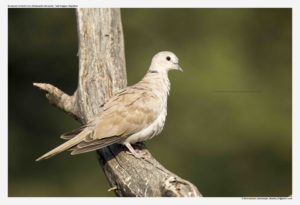Eurassian Collared Dove

Eurasian Collared Dove Streptopelia decaocto
Etymology:
- Streptopelia : Greek word streptos-collar, neck-chain; peleia -dove
- Decaocto: Latin word deca- ten; octo -eight; Greek Myth – a hard-worked maidservant, bemoaning her pay of a miserly 18 pieces a year, prayed for release and was changed by the gods into a dove that echoed her mournful cries
Vernacular Names: Baluchistan: Jangli kapoth, Sind: Gero, Hindi: Dhor fakhta, Parki, Panduk, Gugi, Kash: Kukil, Pun: Ghuggi, Bi: Daolo, Doula, Ben: Par ghughu, Ass: Set kopou, Cachar: Daota gophu, Guj: Dhol, Holo, Mar: Pitha/ Kanthwala hola, Kavda, Ori: For doves – Kapota, Ta: Kalli pura, Sambal pura, Te: Pedda bella guwa, Mal: Pottanchengali, Sinh: Maha kobeyiya
Distribution in India: Widespread resident across India except in Himalayas.
Description: Size of 31-32 cm. The forehead and crown are pale grey often merging into vinous-buff on nape and hind neck; mantle is sandy brown; black half-collar crosses hind neck bordered by white above and below; lores and ear-coverts pale grey merging into vinous on chin, throat, sides of neck and breast; belly and flanks pale grey, darker on under tail-coverts; mantle, back, scapulars, lesser wing-coverts, tertials and tail sandy grey-brown; alula, greater and primary-coverts and secondaries pale grey, latter with brownish-grey tips; primaries dusky brown, underwing greyish white; outer retrices dark grey basally, pale grey distally with broad greyish-white tips; iris deep red; orbital ring cream; bill is black; legs mauve-red. Both sexes are alike.
Habitat: It is found semi-desert and arid country with scattered trees such as Acacia; towns and cities, parks, orchards and gardens
Food Habits: It eats seed, cereal grain, fruits of herbs and grasses and some green parts of plants. It also eats beetles, flies, maggots and small molluscs .Although most food is taken on the ground, birds may fly up with rapid wingbeats to pluck berries from bushes and trees. Large numbers may gather locally to feed on animal fodder and around grain stores.
Breeding Habits: They breed in Mar-Oct. The nest is a flimsy platform made of twigs, stems and roots; may be bulky at times and materials added when rearing second and later broods; placed in bushes, trees , tall hedges and such man-made structures as pylons, buildings, roof troughs or gutters.They lay a clutch of 1-4 eggs. The incubation period is 14–18 days and fledging period is 15–19 days. Young become fully independent in 1 week after fledging.